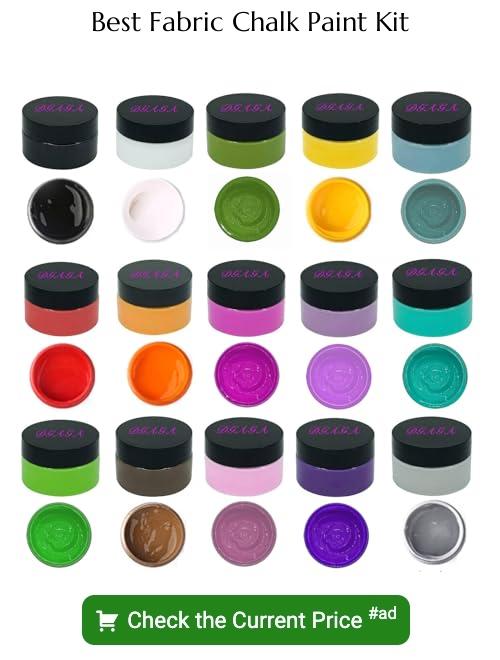Last updated on
Dive into a step-by-step guide focused on exposing the strategies of transforming ordinary fabric into artistic masterpieces using chalk paint.
Key takeaways:
- Choose the right fabric for maximum absorption and even finish.
- Use chalk paint specifically designed for fabric for best results.
- Gather necessary supplies like brushes and water spray bottle.
- Prep the fabric by cleaning, ironing, and lightly dampening it.
- Apply the chalk paint using techniques like dilution, stippling, and layering.
Selection of Fabric
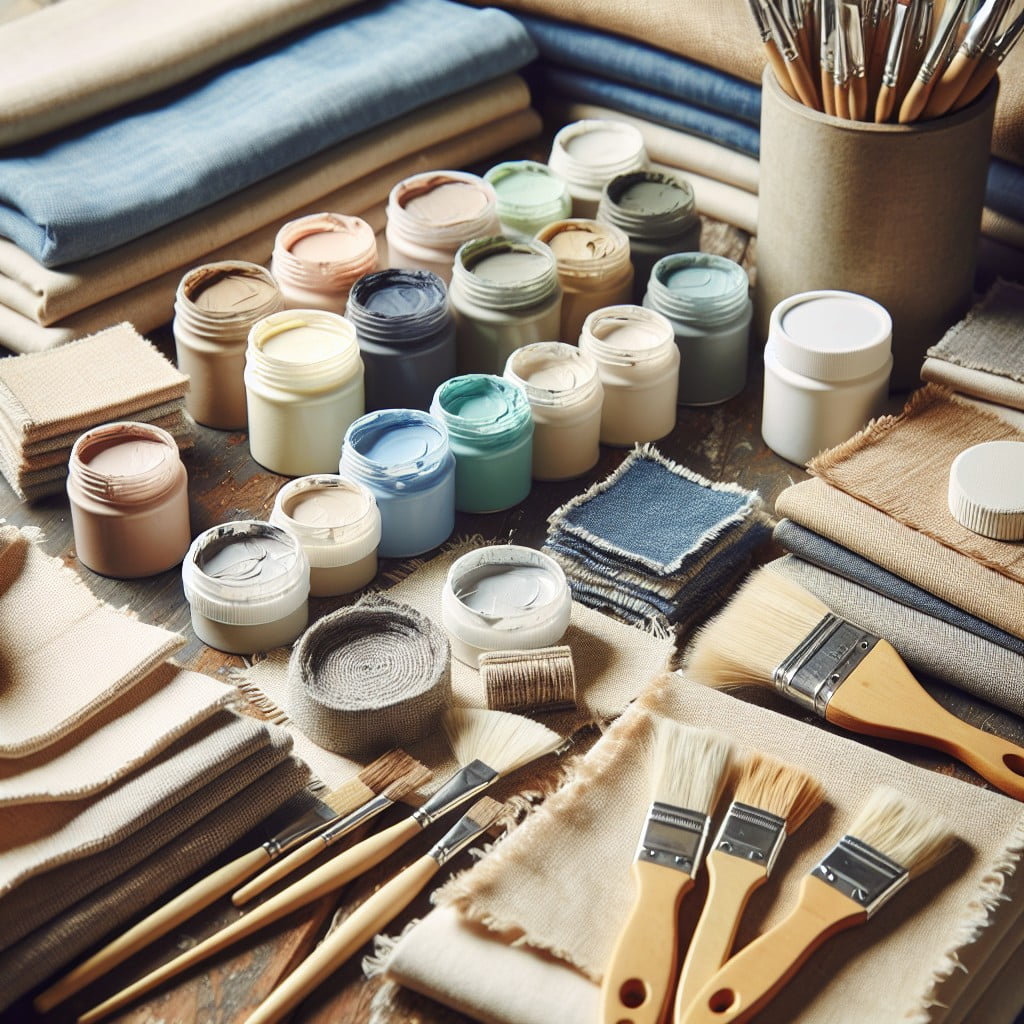
Choosing the right fabric is crucial for the success of your chalk paint project. Natural fibers like cotton and linen are ideal because they absorb paint well, leading to a more even finish. Synthetic fabrics can be used but may require additional preparation and a fabric medium to ensure the paint adheres properly. Fabrics with a tight weave provide a smooth surface, while a looser weave can give a more textured effect.
Always consider the end use of the fabric; upholstery may need a more durable approach than a decorative piece. Before committing to a large project, test a small section to see how the fabric reacts to the chalk paint.
Types of Chalk Paint Suitable for Fabric
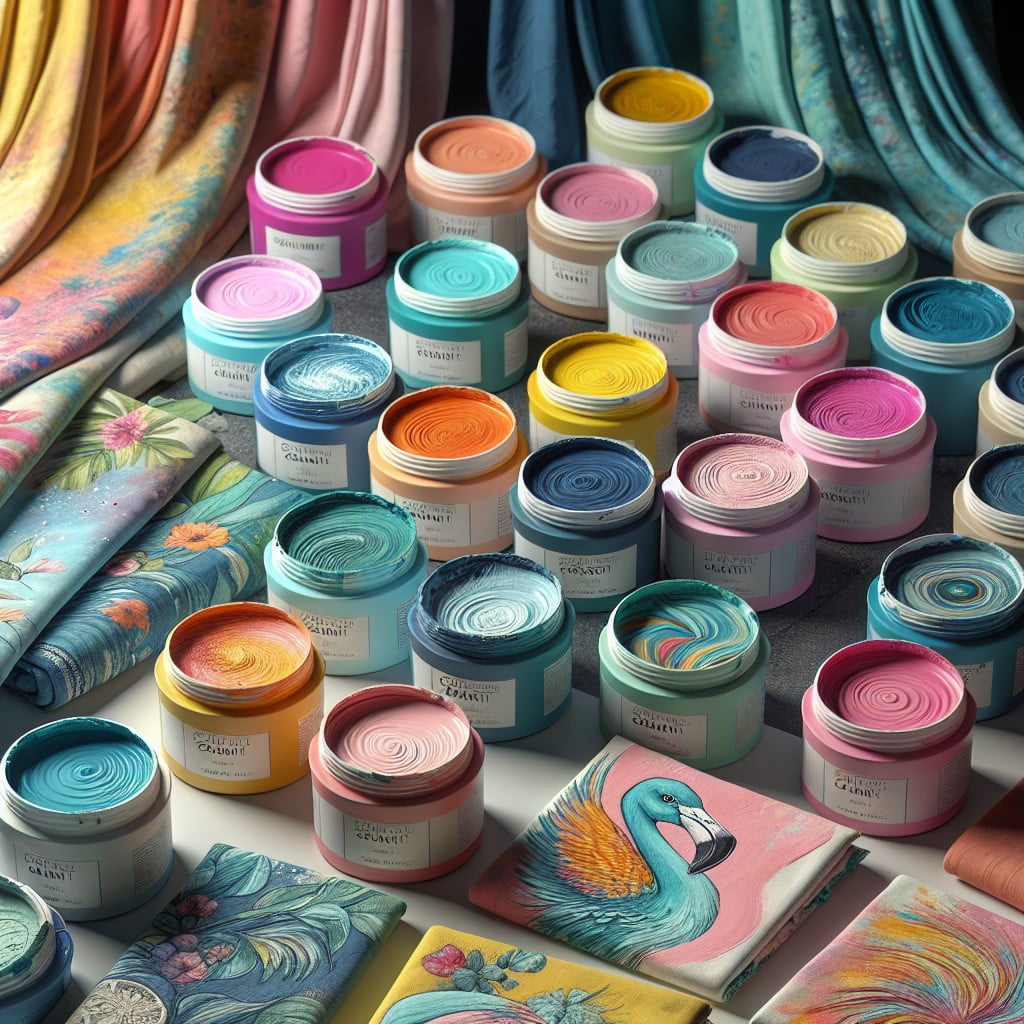
When selecting a chalk paint for your fabric projects, it’s important to choose a brand that offers a formula specifically designed for fabric or one that is known for its versatility on multiple surfaces. Some brands formulate their chalk paint with fabric in mind, ensuring that it dries soft and flexible, which is essential for maintaining the comfort and wearability of the fabric.
Look for chalk paints that are non-toxic and water-based, as these types will allow for easier clean-up and be more environmentally friendly. Additionally, a high-quality chalk paint will offer excellent coverage, meaning you won’t need to apply many coats to achieve an opaque finish.
Keep in mind that not all chalk paints are created equal. Paints labeled as ‘chalk-style‘ or ‘chalky finish‘ may not have the same properties and might not adhere to fabric as well. Ensure the paint you select is suitable for your specific type of fabric, as heavier upholstery may require a thicker paint compared to a thinner, more delicate material.
For best results, consider brands that have been tested and reviewed by other fabric painters. Online forums and craft communities are excellent resources for recommendations. Once you’ve picked your paint, remember to follow the manufacturer’s instructions for application and drying times, as these can vary between products.
Supplies Needed
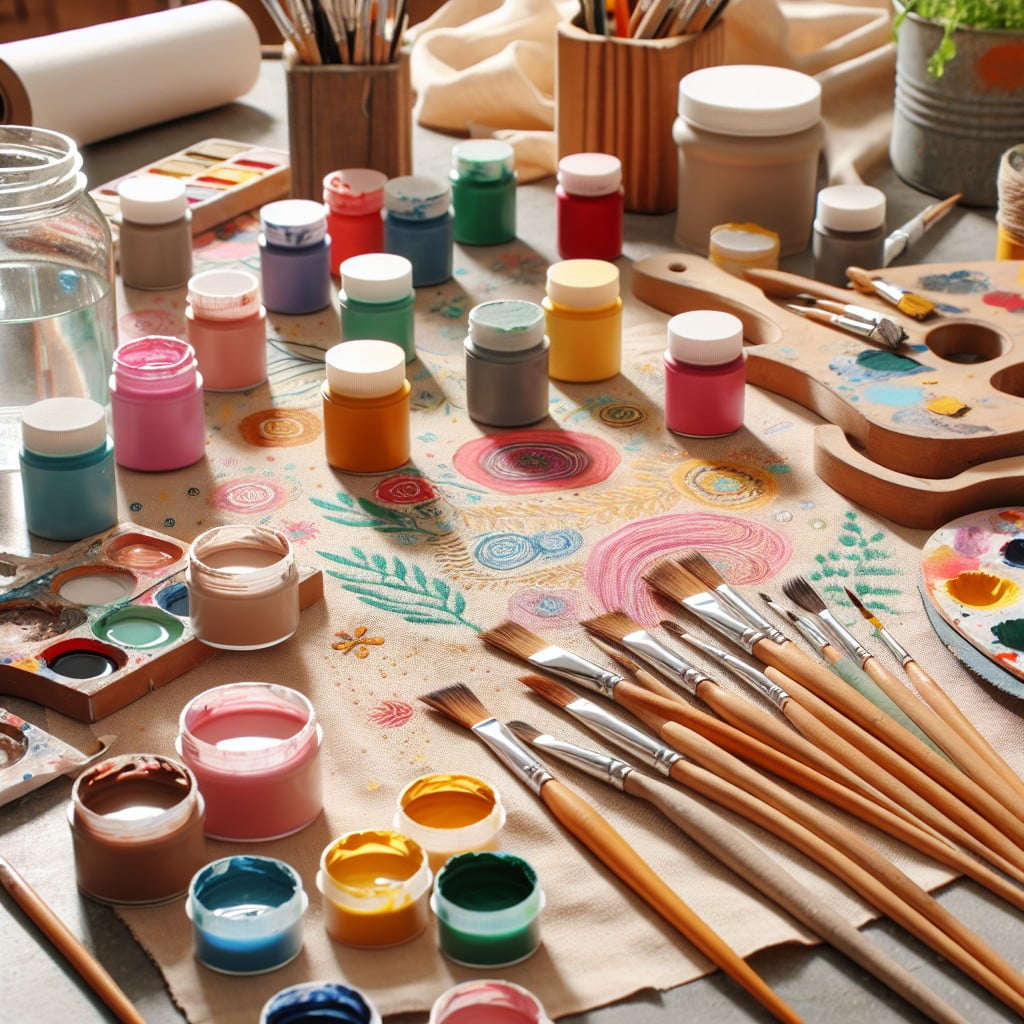
Begin your project by gathering all the necessary supplies to ensure a smooth painting process. This includes the fabric or item you plan to paint, such as a cushion cover or a piece of furniture upholstery. Select a high-quality chalk paint specifically designed for fabric use; this will provide the best coverage and adherence. Acquire a selection of brushes suitable for your fabric’s texture and the size of your project. A spray bottle filled with water is essential for dampening the fabric, which helps the paint to spread more evenly. For mixing and thinning the paint, if desired, have a mixing container and stirring stick ready. To protect the work area, lay down a drop cloth or old sheets. Always keep a clean rag or paper towels handy for any spills or to wipe your brush. Lastly, consider having a fine-grit sanding sponge on standby, which can be used after painting to soften the texture of the fabric.
Preparing the Fabric for Painting
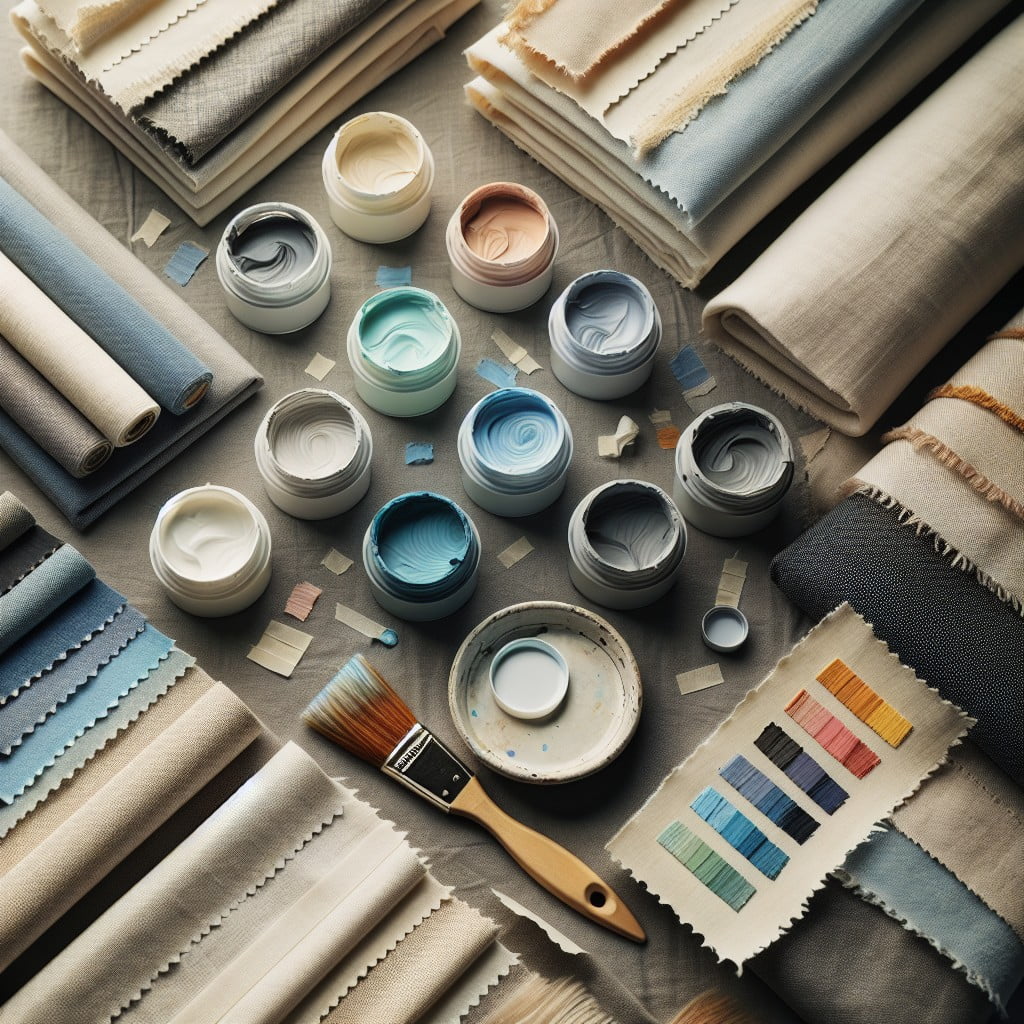
Before diving into the transformation process, it’s crucial to lay a sturdy foundation for the chalk paint to adhere to. Begin by thoroughly cleaning the fabric to remove any dirt, oils, or residues that could prevent the paint from bonding. If the fabric is washable, use a gentle detergent and let it dry completely. Non-washable fabrics can be spot cleaned with a damp cloth.
Iron out any wrinkles to ensure a smooth painting surface. If working with upholstery, vacuum the fabric first to eliminate dust and particles. Once the fabric is clean, you may want to lightly spritz it with water to make it slightly damp. This step helps the paint to soak in more evenly, reducing the chances of a patchy finish.
If your fabric is dark and you’re aiming for a lighter paint color, applying a primer might be necessary to avoid multiple coats of chalk paint. Opt for a fabric primer to maintain the flexibility of the fabric. Allow the primer to dry fully according to the manufacturer’s instructions.
Now that the canvas is prepped, it’s the perfect time to lay down drop cloths or plastic sheets to protect the surrounding area from any potential splatters or spills. With these preparations complete, you’re ready to embark on your fabric painting journey.
Techniques for Applying Chalk Paint to Fabric
Applying chalk paint to fabric requires a delicate balance between enough coverage to ensure color vibrancy and a light enough touch to maintain the fabric’s natural feel. Here are a few techniques to achieve the best results:
1. Dilution for Smoothness: If the paint is too thick, you can thin it with a bit of water. This helps it penetrate the fabric fibers more evenly, reducing stiffness once it dries.
2. Stippling for Texture: Use a stippling brush to “pounce” the paint onto the fabric. This technique helps to mimic a woven texture and hides imperfections.
3. Brushwork for Direction: Pay attention to the direction of your brush strokes. Long, smooth strokes help to create an even finish, while cross-hatching can give a more textured, layered look.
4. Layering for Depth: Build up the color in thin layers, allowing each layer to dry before applying the next. This not only enhances color depth but also prevents the fabric from becoming too stiff.
5. Spraying for Evenness: A spray bottle can be used to lightly mist the fabric with water before painting. This helps the paint to spread more easily and promotes an even application.
6. Blotting for Softness: After painting, gently blot the surface with a cloth to soak up excess paint. This can prevent the fabric from hardening too much once the paint sets.
Remember, patience is key. Take your time and allow each layer to dry thoroughly to achieve a professional, long-lasting finish.
Drying Time and Setting Chalk Paint On Fabric
After applying chalk paint to your fabric, allow it sufficient time to dry completely. The drying process typically takes about 24 hours, but this can vary depending on environmental factors such as humidity and temperature. A well-ventilated area speeds up drying and helps prevent any musty odors from developing, especially if you’re working with a thicker fabric.
To ensure that the chalk paint sets into the fabric properly, consider using a heat setting method. This can be done with an iron set to a medium or warm setting without steam. Place a cotton cloth or parchment paper between the painted fabric and the iron to protect the paint and avoid direct contact. Gently press the iron over the fabric for a few minutes, moving consistently to prevent scorching. This step helps to bind the paint more securely to the fabric fibers, enhancing durability and washability.
Remember, before sitting on or using the fabric in any functional way, verify that the paint is not only dry to the touch but has also fully set to avoid any unwanted transfer or smudging.
Sanding Chalk Painted Fabric for Softness
Once your chalk paint has fully dried on the fabric, you might notice a stiff texture. To achieve a softer, more desirable finish, gently sand the painted areas with fine-grit sandpaper. Lightly sanding breaks up the paint’s surface, making the fabric more pliable without compromising the design. Use a barely-pressured, back-and-forth motion, and avoid over-sanding to prevent damage to the fibers.
After sanding, wipe away any dust using a lint-free cloth to reveal a smoother, softer fabric surface ready for daily use or display.
Sealing and Protecting Painted Fabric
Once your fabric’s new chalk paint finish has completely dried, it’s crucial to seal it to preserve your hard work. Sealing makes the painted surface more durable and resistant to wear and tear.
Here are the key points to ensure your fabric stays in great condition:
- Use a wax-based fabric sealant specifically designed for chalk paint. Soft wax doesn’t alter the flexibility of the fabric and keeps the colors vibrant.
- Apply the sealant with a soft cloth or wax brush in a thin, even layer. Work the sealant into the fabric in a circular motion to ensure full coverage.
- Allow the first coat to dry thoroughly, according to the product’s instructions, before considering a second coat. Multiple thin coats are more effective than one thick coat.
- For high-traffic items, such as upholstery, opt for a second coat of sealant for extra protection.
- Always test your sealant on a small, inconspicuous area to gauge its effect on the color and texture of the fabric.
- Keep the fabric untouched and away from heavy use for a few days to let the sealant cure completely, ensuring maximum durability.
Remember, properly sealed fabric helps your project remain looking fresh and makes it easier to clean and maintain.
Assessing the Texture of Painted Fabric
Chalk paint often changes the feel of fabric, giving it a stiffer texture. This transformation isn’t necessarily negative, as it can add a certain robustness to the material.
To ensure the finished product meets expectations, consider the following:
- Test on a small area first. Before applying chalk paint to an entire piece, test on a scrap or inconspicuous area to evaluate the change in texture.
- Expect a certain degree of stiffness. Chalk paint contains ingredients that may harden the fabric once dry.
- Softness can be achieved. After the paint dries, gently sanding the fabric can restore some softness.
- Consider the use of fabric medium. Mixing in a fabric medium with the chalk paint can significantly enhance the flexibility of the finished product.
- Factor in the type of fabric. Thinner fabrics may become more rigid compared to heavier ones, which might already be able to support the added weight of the paint.
- Touch is telling. After the paint and any sealant have dried, run your hand over the fabric to feel for an even texture and make adjustments if necessary.
Maintaining Chalk Painted Fabric Upholstery
To ensure the longevity of your chalk-painted fabric upholstery, regular maintenance is essential. Gently vacuum the surface with an upholstery attachment to remove dust and dirt; this avoids the build-up that can dull the colors.
If soiling or spills occur, wipe immediately with a damp cloth. Avoid using chemical cleaners, as they may react negatively with the chalk paint. For a deeper clean, concoct a mild soapy solution using water and a small amount of gentle detergent. Test this on an inconspicuous area first to check for colorfastness.
To refresh the paint after cleaning or over time, apply a light coat of wax, working it into the fabric with a soft cloth. This not only enhances the color but adds a protective layer against wear and tear. Remember, waxing might slightly darken the paint color. Always conduct a patch test first.
In the case of chalk-painted fabric items that are used frequently, like cushions or chair seats, consider using a throw or decorative slipcover as an additional protective barrier. This is both practical and stylish, adding a new dimension to décor while safeguarding your handiwork.
Troubleshooting Common Issues With Chalk Paint On Fabric
When tackling issues with chalk paint on fabric, consider the following solutions:
Stiffness: Newly painted fabric can feel rigid. Soften it by lightly sanding the surface once the paint has dried or by applying a fabric medium mixed with the chalk paint.
Uneven Coverage: If the first coat isn’t smooth, don’t worry. Apply additional thin coats until you achieve even coverage. The key is patience and allowing ample drying time between coats.
Bleed Through: Dark fabrics may cause paint colors to shift. Apply a test patch. If bleeding occurs, use a primer designed for fabrics or choose a paint with built-in sealing properties.
Cracking: Flexibility is crucial for fabric paint. Avoid thick layers to minimize the chance of cracking. A fabric medium mixed with your paint can enhance flexibility.
Fading: Exposure to sunlight or frequent washing can dull your masterpiece. Protect the paint with a fabric sealer and wash gently to preserve colors longer.
Address these common issues and you’ll be on your way to achieving beautiful, professional-looking results on your fabric painting project.
Step-by-Step Guide to Painting Fabric With Chalk Paint
Begin by laying out your pre-washed and ironed piece of fabric on a flat surface. If it’s a piece of furniture, ensure it’s clean and properly prepped.
Stir your chalk paint well to achieve a consistent color and texture. For a smoother finish, diluting with a small amount of water may be necessary.
Dip your brush into the paint, removing excess to avoid dripping. Apply the first coat of chalk paint using even strokes. If you’re working on upholstery, consider painting in the direction of the fabric weave for uniformity.
Allow the initial coat to dry completely, usually taking about 30-60 minutes, depending on the environment.
Once the first layer is dry, inspect for coverage. Apply a second coat if needed, using the same even brushing technique.
After the final coat has dried, lightly sand the fabric with fine sandpaper if a softer texture is desired, being careful not to remove the paint.
Set the paint by gently pressing a cloth over it with a warm iron, or use a heat gun at a safe distance to avoid scorching.
Remember to work in a well-ventilated area and to clean your brushes immediately after use. This straightforward approach leads to a beautifully updated fabric with a fresh, matte finish.
The Durability of Chalk Paint On Fabric
Chalk paint adheres well to fabric and, once set, creates a long-lasting finish.
If sealed properly with a fabric medium or wax, the paint can withstand regular use and gentle washes.
Factors influencing durability include the fabric’s texture, the type of chalk paint used, and the application process.
Thinner layers of paint maintain fabric flexibility, whereas thicker layers yield a more rigid surface that might crack over time.
To ensure longevity, avoid painting high-wear areas such as seat cushions without adequate sealing.
Regular maintenance, including spot cleaning and minimal agitation during washing, helps preserve the integrity of the painted fabric, ensuring your creative work stays vibrant and enduring.
Extra Tips for Working With Chalk Paint On Upholstery
Consider the following points when working with chalk paint on upholstery to achieve the best results:
- Work in Sections: To prevent paint from drying unevenly, tackle small areas at a time. This approach allows for better control and ensures a more uniform appearance.
- Keep a Spray Bottle Handy: A fine mist of water applied to the fabric before painting can help the chalk paint adhere better and spread more smoothly.
- Use Minimal Paint: Apply thin layers to avoid stiffness and to allow the fabric’s texture to show through. Multiple thin coats are preferable to one thick one.
- Avoid Direct Sunlight: While drying, keep the painted upholstery out of direct sunlight to prevent the paint from drying too quickly, which can lead to cracking.
- Good Ventilation: Ensure the workspace is well-ventilated to aid in the drying process and for your comfort and safety.
- Testing First: Before starting on the main project, test the paint on a small, inconspicuous area to check for colorfastness and adherence.
By applying these extra tips, you can improve the application process and outcome of your upholstery projects with chalk paint.
FAQ
Can chalk paint be used on fabric?
Yes, chalk paint can be used on fabric, when diluted with water to create a wash, ensuring the fabric is not soaked or caked in paint.
How do you seal chalk paint on upholstery?
Sealing chalk paint on upholstery is effectively accomplished by applying a coat of clear wax, which enriches the paint color, provides a matte finish, and offers protection against fingerprints and stains, with the additional benefit of being water-repellent for easy cleaning.
How many coats of chalk paint on fabric?
Typically, three coats of chalk paint are needed on fabric for full coverage, allowing each coat to fully dry before applying the next.
What is the ratio of chalk paint to water for fabric?
The ideal ratio of chalk paint to water for fabric is one to one.
Does the type of fabric affect the application of chalk paint?
Yes, the type of fabric can affect the application of chalk paint because of variations in absorption, texture, and durability.
What is the drying time for chalk paint on fabric?
The drying time for chalk paint on fabric is typically between one to two hours.
Are there any specific techniques for applying chalk paint on upholstery?
Yes, for applying chalk paint on upholstery, the key technique involves watering down the paint for a thinner consistency before working it into the fabric with a brush.
Recap:
